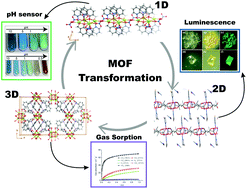Transforming metal–organic frameworks into functional materials
Abstract
This review focuses on a new alternative approach towards MOF preparation through the transformation of known MOF structures into other novel, more active MOFs that, in most cases, could not be obtained by conventional synthetic methods. These transformations are usually of the single-crystal-to-single-crystal type, usually accompanied by a modification of the dimensionality of the MOFs: e.g., 1D → 2D, 2D → 3D, 1D → 3D or even 3D → 3D′ (concerning modification of the connectivity of the primary building units). The literature contains several reports concerning MOF-to-MOF transformations but only in a handful of cases the authors aimed to design new functional compounds, pointing towards applications or the modification (or improvement) of the properties of the materials. This review aims to concisely describe the most significant reports concerning the transformation of MOFs into other more functional and active MOFs. Several types of transformations are possible including solvent removal or insertion, modification of the pH, metal exchange, release of active molecules, among others. These transformations can lead to significant improvements of the properties of MOFs, for example: increase of adsorption of different gases, such as nitrogen and carbon dioxide; creation of sensing centers for different chemical species; pH sensing with, in some cases, a concomitant change in crystal color; improvement of the luminescence properties by the removal of solvent molecules. Other transformations could lead instead to a complete modification of the properties of MOFs such as the appearance of magnetic properties, the creation of storage devices, the design of releasing materials by the incorporation of active molecules or water scavengers.

- This article is part of the themed collections: 2015 Inorganic Chemistry Frontiers Review-type Articles and Crystal engineering for molecular materials

 Please wait while we load your content...
Please wait while we load your content...